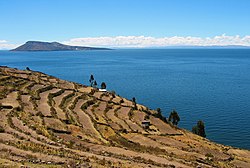Columbian Exchange
From Wikipedia, the free encyclopedia
| This article is missing citations or needs footnotes. Please help add inline citations to guard against copyright violations and factual inaccuracies. (November 2008) |
The Columbian Exchange has been one of the most significant events in the history of world ecology, agriculture, and culture. The term is used to describe the enormous widespread exchange of plants, animals, foods, human populations (including slaves), communicable diseases, and ideas between the Eastern and Western hemispheres that occurred after 1492. Many new and different goods were exchanged between the two hemispheres of the Earth, and it began a new revolution in the Americas and in Europe. In 1492, Christopher Columbus' first voyage launched an era of large-scale contact between the Old and the New Worlds that resulted in this ecological revolution: hence the name "Columbian" Exchange.
The Columbian Exchange greatly affected almost every society on earth, bringing destructive diseases that depopulated many cultures, and also circulated a wide variety of new crops and livestock. Maize and potatoes became very important crops in Eurasia by the 18th century. Manioc and the peanut flourished in tropical Southeast Asian and West African soils that otherwise would not produce large yields or support large populations.
Contents |
[edit] Examples
This exchange of plants and animals transformed European, American, African, and Asian ways of life. Of the world's top 26 crops, measured by weight of production, eight originated in the Americas.[citation needed] One third of the crop value within the United States depends on foods that were first grown in the Americas.[citation needed]
New foods became staples of human diets and new growing regions opened up for crops. For example, before AD 1000, potatoes were not grown outside of South America. By the 1840s, Ireland was so dependent on the potato that a diseased crop led to the devastating Irish Potato Famine. One of the first European imports, the horse, changed the lives of many Native American tribes on the Great Plains, allowing them to shift to a nomadic lifestyle based on hunting bison on horseback. Tomato sauce, made from New World tomatoes, became an Italian trademark, while coffee from Africa and sugar cane from Asia became the main crops of extensive Latin American plantations. Also the chili/paprika from South America was introduced to India by the Portuguese and is today an integral part of Indian cuisine.
Before the Columbian Exchange, there were no oranges in Florida, no bananas in Ecuador, no paprika in Hungary, no tomatoes in Italy, no coffee in Colombia, no pineapples in Hawaii, no rubber trees in Africa, no cattle in Texas, no donkeys in Mexico, no chili peppers in Thailand and India, no cigarettes in France and no chocolate in Switzerland. Even the dandelion was brought to America by Europeans for use as an herb.
Before regular communication had been established between the two hemispheres, the varieties of domesticated animals and infectious diseases, such as smallpox, were strikingly larger in the Old World than in the New. This led, in part, to the devastating effects of Old World diseases on Native American populations. The smallpox epidemics probably resulted in the largest death toll for Native Americans.
Scarcely any society on earth remained unaffected by this global ecological exchange.
| Type of organism | Old World to New World | New World to Old World |
|---|---|---|
| Domesticated animals | ||
| Domesticated plants |
|
|
| Infectious diseases |
[edit] Unintentional introductions
In addition to the diseases mentioned above, many species of organisms were introduced to new habitats on the other side of the world accidentally or incidentally. These include such animals as brown rats, earthworms (apparently absent from parts of the pre-Columbian New World), and zebra mussels. Plants thus introduced include many weeds, such as tumbleweeds, wild oats, and kudzu. Even fungi were transported, such as the one responsible for Dutch elm disease. Some of these species became serious nuisances upon being established. Plants that were introduced to Europe after 1492 are so-called Neophytes, whereas plants that made it over the sea before that date are called Archaeophytes.
[edit] See also
- Alfred Crosby
- Domestication
- Guns, Germs, and Steel
- Population history of American indigenous peoples
- Pre-Columbian trans-oceanic contact
- Transformation of culture
[edit] Sources
- The Columbian Exchange: Plants, Animals, and Disease between the Old and New Worlds in the Encyclopedia of Earth by Alfred W. Crosby
- Worlds Together, Worlds Apart by Jeremy Adelman, Stephen Aron, Stephen Kotkin, et al.
- New study blames Columbus for syphilis spread from Reuters Jan 15, 2008
[edit] External links
- Foods that Changed the World
- The Columbian Exchange study guide, analysis, and teaching guide
- NBC News piece on Columbian Exchange


